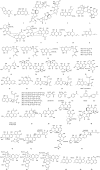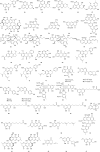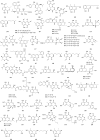Recent advances in the structures and bioactivities of benzopyrans derived from marine fungi: a review
- PMID: 39512833
- PMCID: PMC11540774
- DOI: 10.3389/fphar.2024.1482316
Recent advances in the structures and bioactivities of benzopyrans derived from marine fungi: a review
Abstract
Marine fungi represent a treasure trove of bioactive secondary metabolites, with benzopyran compounds emerging as a significant class of these natural products. This review delves into the structural diversity, biological activities, and sources of benzopyran compounds, highlighting their isolation from marine fungi inhabiting diverse environments such as sponges, marine sediments, algae, mangroves, and corals. Our literature search, conducted from 2000 to 2023, has identified a wealth of benzopyran compounds, showcasing their potential as lead compounds in drug development. The characteristics of benzopyran from marine fungi are explored, encompassing various subclasses such as chromones, isocoumarins, citrinins, and other related compounds. These compounds exhibit a remarkable chemical diversity, which is crucial for their diverse biological activities. The potential of benzopyran compounds in drug development is also discussed, emphasizing their roles in anti-tumor, antibacterial, anti-inflammatory, and enzyme inhibitory activities. In recent years, a remarkable 210 bioactive benzopyran compounds have been isolated from the secondary metabolites of marine fungi. These findings underscore the importance of marine fungi as a source of novel bioactive compounds, offering a plethora of potential lead compounds for the development of marine-derived drugs. This review aims to provide a comprehensive overview of the current state of research on benzopyran compounds, setting the stage for future advancements in the field of marine natural products.
Keywords: benzopyrans; biological activity; isolation and identification; marine fungi; secondary metabolites.
Copyright © 2024 Xi, Wang, Sun, Ma, Zhang and Zhang.
Conflict of interest statement
The authors declare that the research was conducted in the absence of any commercial or financial relationships that could be construed as a potential conflict of interest.
Figures










Similar articles
-
Research Advances of Bioactive Sesquiterpenoids Isolated from Marine-Derived Aspergillus sp.Molecules. 2022 Oct 30;27(21):7376. doi: 10.3390/molecules27217376. Molecules. 2022. PMID: 36364202 Free PMC article. Review.
-
Bioactive steroids from marine-derived fungi: a review (2015-2023).J Asian Nat Prod Res. 2025 Feb 24:1-27. doi: 10.1080/10286020.2025.2464690. Online ahead of print. J Asian Nat Prod Res. 2025. PMID: 39989344 Review.
-
Origins, Structures, and Bioactivities of Secondary Metabolites from Marine-derived Penicillium Fungi.Mini Rev Med Chem. 2021;21(15):2000-2019. doi: 10.2174/1389557521666210217093517. Mini Rev Med Chem. 2021. PMID: 33596801
-
Diterpenoids of Marine Organisms: Isolation, Structures, and Bioactivities.Mar Drugs. 2025 Mar 18;23(3):131. doi: 10.3390/md23030131. Mar Drugs. 2025. PMID: 40137317 Free PMC article. Review.
-
The Genus Cladosporium: A Prospective Producer of Natural Products.Int J Mol Sci. 2024 Jan 29;25(3):1652. doi: 10.3390/ijms25031652. Int J Mol Sci. 2024. PMID: 38338931 Free PMC article. Review.
Cited by
-
Microbial community succession during tobacco fermentation reveals a flavor-improving mechanism.Front Bioeng Biotechnol. 2025 Jul 21;13:1627842. doi: 10.3389/fbioe.2025.1627842. eCollection 2025. Front Bioeng Biotechnol. 2025. PMID: 40761543 Free PMC article.
-
The Cytotoxic Activity of Secondary Metabolites from Marine-Derived Penicillium spp.: A Review (2018-2024).Mar Drugs. 2025 Apr 30;23(5):197. doi: 10.3390/md23050197. Mar Drugs. 2025. PMID: 40422787 Free PMC article. Review.
References
Publication types
LinkOut - more resources
Full Text Sources
Molecular Biology Databases

